Has anyone tried "conservation" via window sun exposure?
 logger7
Posts: 9,251 ✭✭✭✭✭
logger7
Posts: 9,251 ✭✭✭✭✭
I had a $20 Liberty in an old PCGS rattler holder, "MS63". I thought it would upgrade at NGC so cracked it and submitted it. It came back as "Unc details, cleaned". Looking closer at the coin I saw light old hairlines. I put it on a windowsill with sun exposure for a month or so, then resubmitted; it came back "MS64"!
A dealer told me an experience the other day with a copper coin that had been dipped and turned an "orange" color. He tried the sunny windowsill, and some months later it had turned an attractive red color and graded MS64 rb he said.
1
Comments
You're kidding, right!?
What you and the dealer did wasn’t “conservation.”
Mark Feld* of Heritage Auctions*Unless otherwise noted, my posts here represent my personal opinions.
The copper coin, I agree. The gold coin shouldn't have changed in the sunlight. It more likely just slipped through with the hairlines.
All comments reflect the opinion of the author, even when irrefutably accurate.
A month or so on a windowsill toned (or created enough patina) on a gold coin to hide hairlines?
Never tried a windowsill, I’ve had my best luck with albums for silver and nickel, and old kraft style envelopes for copper, and long term storage, 5 years +.
Gold is much different than silver or copper. I would love to see photos, before and after.
"But seek ye first the kingdom of God and His righteousness and all these things shall be added unto you" Matthew 6:33. Young fellow suffering from Bust Half fever.
BHNC #AN-10
JRCS #1606
Your “more likely” explanation still wasn’t “conservation.”
Mark Feld* of Heritage Auctions*Unless otherwise noted, my posts here represent my personal opinions.
What falls under "conservation"? He did put it in quotation marks. It's not conservation but it could be "conservation". 🤣 although I agree with you, I would call it "reconsideration "... unless the sun is really hot in his universe.
All comments reflect the opinion of the author, even when irrefutably accurate.
I distinctly recall a story John J Ford Jr told me many decades ago. He’d laid a choice ExF 1793 Chain cent on his office window sill exposed to the sunlight to get the cleaned red surface to tone brown over a year’s time. He came home one day to find his wife had arranged for the home exterior to be painted and sure enough the large cent was gone.
I won a darkly grey toned mint state Oak Tree XII in an early Bowers & Ruddy auction for $2800 after Bob Hughes consigned it, having priced it in stock at $8000. I dipped it revealing alot of gleaming original lustre but a bright surface. I put it out on a wood bench in my backyard under a convex clear glass shallow bowl, exposed to the summer sunrays. The glass convex shallow bowl magnified the suns rays. After a bit more than 6 months the shilling had beautiful golden and irridescent blue toning and booming original lustre. That shilling is now the finest known OT Xii of any variety and is slabbed as MS65+ and has auctioned well into 6 figures.
Again. COPPER IS NOT GOLD!
All comments reflect the opinion of the author, even when irrefutably accurate.
what happened to the large cent and hows that related
Proud follower of Christ!
Older US gold coins can tone since they are alloyed with 10% copper. I can see it being possible for a gold coin to get a little toning if it were in direct sunlight for a long enough period of time.
Worry is the interest you pay on a debt you may not owe.
"Paper money eventually returns to its intrinsic value---zero."----Voltaire
"Everything you say should be true, but not everything true should be said."----Voltaire
This harkens back to the days of Taco Bell napkins.
If my understanding of the chemistry is correct, silver demonstrates very strong photochemical properties but copper and gold do not. So exposure to sunlight alone should not affect the toning of non-silver coins.
If "the windowsill treatment" affects toning of copper and gold-copper alloy coins, then the effect is caused by either increased heat, or increased exposure to atmospheric moisture and sulfur.
I think the moral of that story is, "be careful which windowsill you choose to use to leave coins sitting around on, lest the coins find themselves nicely re-toned but no longer in your possession".
Roman emperor Marcus Aurelius, "Meditations"
Apparently I have been awarded the DPOTD twice.
Quite possible that the residue and/or toning that was already present on the windowsill coins is what aged/toned in the sunlight.
Millions of coins of all types have been left out in the sun in every imaginable scenario so I think/hope we'd already know if sunlight was "conservation" magic.
Perhaps not "toning" per se, but microns of dust. I'd think the sun's heat and variability may affect the metal or the heat of the metal is more likely to have humidity in the air deposit tiny amounts of motes or other substances in an apartment.
For coins with minor cleanings, like pocket change wear, a better word for window sill storage is remediation, if long term & it works. Conservation, no. Adding a taco napkin, doctoring.
Why is the use of a napkin “doctoring” but window sill storage “remediation”? Each method is an intentional act to change/improve the look of the coin.
Mark Feld* of Heritage Auctions*Unless otherwise noted, my posts here represent my personal opinions.
I'd also add that I'm not sure any "remediation" took place. The problem just got covered.
All comments reflect the opinion of the author, even when irrefutably accurate.
I could see doing that if one puts an ugly bright scrape on a coin's surface or rims. I accidentally hit the rim of a now PCGS VF30 1855/54 half leaving a wicked bright 1-2 mm scrape on the rim. I was furious with myself for damaging my highest-grade cherry pick at that time. I thought about putting it on my windowsill, but that would have been inviting trouble with three dogs and four cats in the house. Fortunately, after about 6 months the coin toned enough that the scrape was no longer conspicuous, and I submitted the coin for grading.
But that wasn’t what I asked. “Why is the use of a napkin “doctoring” but window sill storage “remediation”? Each method is an intentional act to change/improve the look of the coin.”
Mark Feld* of Heritage Auctions*Unless otherwise noted, my posts here represent my personal opinions.
It provides a way to "rehab" the coin more naturally rather than wrapping a coin in a sulfur tainted napkin. As it was, it did retone on its own naturally through normal exposure to air and light. Placing on a windowsill simply speeds up the natural process in a normal household environment. Adding sulfur to alter the coin's environment with napkins is a deliberate chemical alteration of the coin's environment that I feel is significantly different than normal processes occurring in a normal (household) sunlit environment.
Normal chemical environment with sunlight - fine
Adding chemicals to the environment around the coin to rapidly affect color change - not the same and less acceptable IMO.
You can set circulated coins on your furnace if thumbing doesn't fix them.
The taco bell napkin is adding a known chemical to the process. Now you can say our air has more then CO and O, but hopefully its minuscule and most all coins have been exposed to the air, except mint packaged, etc.
.
.
.
"To Be Esteemed Be Useful" - 1792 Birch Cent --- "I personally think we developed language because of our deep need to complain." - Lily Tomlin
IIRC, there is a professional chemist on this board. Can't remember who he is but I'd be interested in what he had to say.
Perhaps using a taco napkin that has been used extensively deserves its own category of unusual efforts.
Thank you for the explanation.
Here’s where I think the slope becomes slippery…
If the napkin in the part of your post quoted below is an issue, shouldn’t placing coins in albums (thought or known to contain sulphur and likely to tone coins) also be an issue?
“Adding sulfur to alter the coin's environment with napkins is a deliberate chemical alteration of the coin's environment that I feel is significantly different than normal processes occurring in a normal (household) sunlit environment.”
Mark Feld* of Heritage Auctions*Unless otherwise noted, my posts here represent my personal opinions.
That's a very fine line you're drawing. Can't i "naturally" want to line my coin cabinet with napkins because velvet is too expensive?
All comments reflect the opinion of the author, even when irrefutably accurate.
Yes.
All comments reflect the opinion of the author, even when irrefutably accurate.
I often wrap coins in random paper, napkins and even dollar bills if I find nice looking ones in circulation or even if I purchase a raw coin at a show that isn’t in a holder I trust. But I don’t do so to tone them, rather it’s to keep them from getting scratches or even to prevent dust from settling on them.
It sounds like the OP is relying on the dust being attracted to hairlines on the surface of the coin, so wrapping it in a napkin might prevent this. Sort of reminds me of that old study someone did a long time ago that verified a theory that clean surfaces have a sort of “charge” that attracts dust, but that if you start with a dusty surface more dust isn’t attracted as much. The author concluded that if you leave a certain thickness protective layer of dust, that additional dust doesn’t accumulate. For sure the guy just didn’t like to dust things, but the study was fascinating.

Mr_Spud
If it's so "natural", why does it have to go on the windowsill?
I don't belive in "natural " or "artificial " toning.
Interestingly, at some point "natural " toning is deemed "environmental damage".
As I've been saying for years, coin albums introduce "unnatural" chemicals to coins. All album toning is artificial, even if accidental. But then I'm always told that it is "natural" to put coins in albums but not in napkins. I'm not buying the intentionality argument, especially when someone is intentionality putting it on a windowsill because of what will happen there.
It was quite "natural" to store Morgan $s in sulfured canvas. Textile toning, anyone? I'll be taking submissions.
All comments reflect the opinion of the author, even when irrefutably accurate.
This is sort of what I was referring to
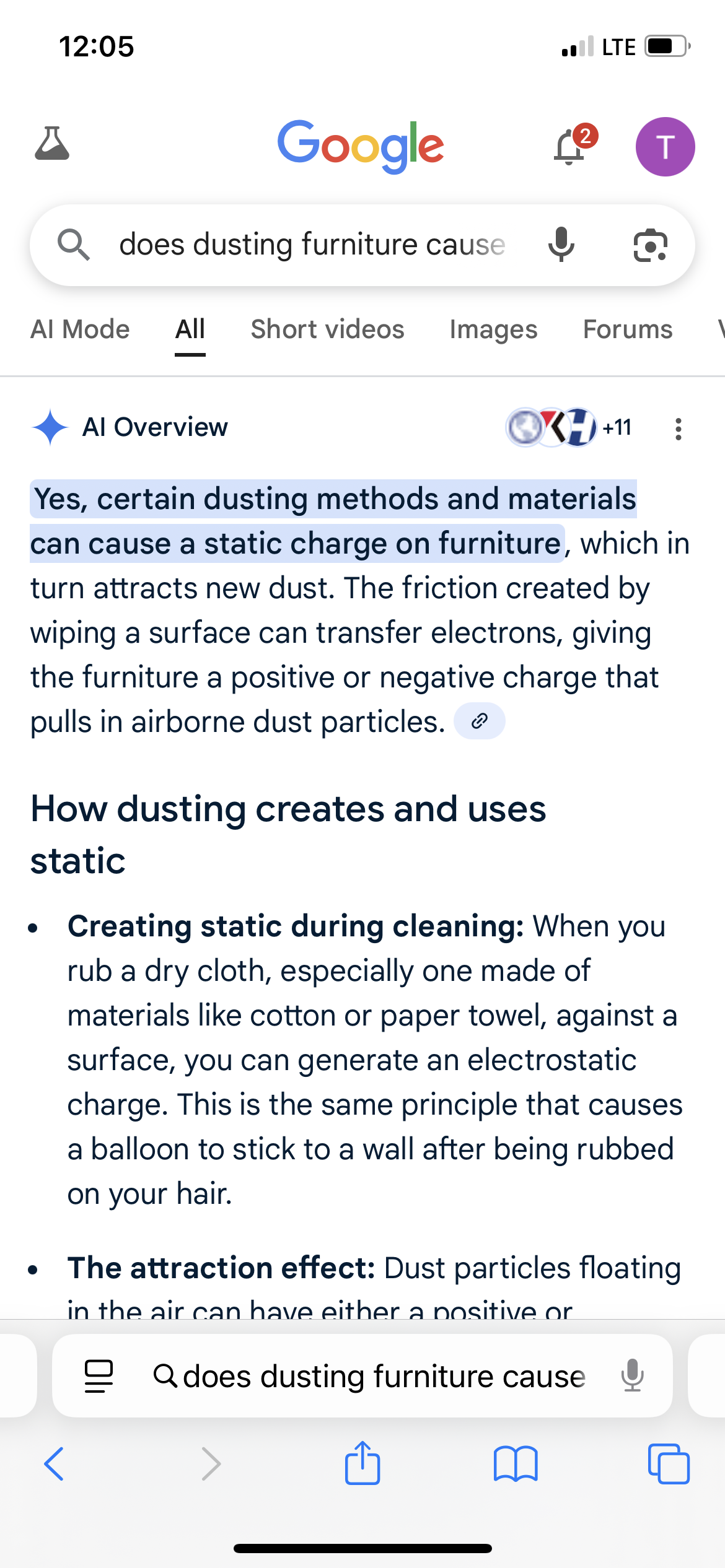
I wonder if freshly scratched metal attracts dust more than metal with a patina
Mr_Spud
Back to the napkin/paper wrapping discussion. I usually remember to unwrap the coins in a timely manner, but sometimes time does slip by and more than once the coins toned some.
Next someone will say it’s about intent.

But one time I intentionally exposed a blast white coin to toning agents, but it just stayed blast white. Does it mean the blast white coin is artificially toned because I intended it to tone?
Inquiring minds need to know
Mr_Spud
No. It will, however, tone faster.
All comments reflect the opinion of the author, even when irrefutably accurate.
Well if you need to store and transport 1,000 dollars weighing about 60 lbs you needed in put in strong canvas bag. Whether the sulfur was part of the manufacturing process back then or intentionally added, not sure, but the sulfur keeps away bugs and mice and fungal infestations.
More than 10 years ago, I was on a committee given the task to come up with a definition of “coin doctoring” to be used by the PNG. Not surprisingly, “artificial toning” (and coin storage methods) were part of the discussion and accompanying disagreements. 😉
Below is our committee’s language adopted by the PNG. See part 3 regarding “natural” toning and storage, etc. as they relate to coin doctoring. And yes, I already know that there’s no perfect way to define “artificial” toning.
According to PNG, coin doctoring refers to the alteration of any portion of a coin, when that process includes any of the following (emphasis added):
https://coinsblog.ws/2012/04/png-defines-coin-doctoring.html
Mark Feld* of Heritage Auctions*Unless otherwise noted, my posts here represent my personal opinions.
So if I use low grade cardboard albums, it's not coin doctoring? I don't buy it.
All comments reflect the opinion of the author, even when irrefutably accurate.
Yes, if these albums contain sulfur. Ideally, a well-preserved silver coin should be near blast white. Intercept Shield products are designed to reduce the air pollution that can tone coins.
Since most albums through the years have contained some sulfur, the resulting toned coins are acceptable up to a point, and even desirable the past 40 years or so. Colorfully toned coins are prized and command a high premium these days. I paid a strong price for this AU58 1875.
The hobby is not perfectly logical and consistent on this corrosion issue, IMO. Most of the coins in my CAC Hall of Shame are CAC stickered coins with original toning but also have what I feel is significant corrosion. I'll use this newly graded 1853-O to illustrate. I bought it for its crusty look but considered returning it because of a lighter colored band of pitting and corrosion across the obverse right field from the cap to Liberty's foot, and also along the sides of Liberty. I kept it, though, figuring it was cheap, and I could get my money back when I sell it.
The 53-O was added to a recent submission to CACG with a chuckle to test my hypothesis that CAC favors originality to the point where they even allow some corroded surfaces. In other words, CACG was the ideal TPG service for grading this crusty, original coin with some rough surfaces. Sure enough, it graded CACG VF20, which is a nice outcome for this inexpensive coin.
It would be nice if PCGS could fix this photo problem.
I’m not asking you to buy it. I’m sure that some people will agree with you and others won’t. But what if you don’t know the albums are low grade? Or what if you accidentally leave a coin in a drawer or somewhere else that causes it to tone - is that coin doctoring, as far as you’re concerned?
Mark Feld* of Heritage Auctions*Unless otherwise noted, my posts here represent my personal opinions.
Nope. Not if you KNOW napkins impart substances that tone and corrode coins. A lot depends on your know-how, methods and motivation to keep these coins properly preserved.
Then we are back to intentionality...
I'm fine with "market acceptable" vs "not marketable ".
Sometimes, I also feel like I'm okay with "doctored". Shall we discuss "curation"/"conservation" vs "doctoring" next? 😈
All comments reflect the opinion of the author, even when irrefutably accurate.
It sounds like you’re making intent a significant part of the definition of doctoring or artificial toning. That can be problematic and lead to silly sounding distinctions.
For example, if two people place coins in a coin cabinet lined with napkins or other material that can cause them to tone, but only one of the persons is aware of that, based on what you wrote, only the one with knowledge is a coin doctor and/or is responsible for artificial toning. The toning’s the same, regardless of intent. So it should be labeled the same in both cases.
Mark Feld* of Heritage Auctions*Unless otherwise noted, my posts here represent my personal opinions.
Well stated. That is the problem with intentionality. This is especially true once they leave the original doctor/non-doctor hands. How am I or the person i sell to supposed to know what the intentions of the person i got it from?
All comments reflect the opinion of the author, even when irrefutably accurate.
Addressing the original question, I have an inexpensive silver world coin that I really like but is unnaturally bright. Over a period of 3 years I left it on the windowsill bare, then wrapped in a napkin, finally I tried placing it in an old leather pouch on the furnace.
I was just hoping to mellow it a bit, but sadly there was little (if any) change. I'm not a very good doctor, apparently.
What if it was an Anti - UV window?
"When they can't find anything wrong with you, they create it!"
FYI - here’s what intercept albums can do to coins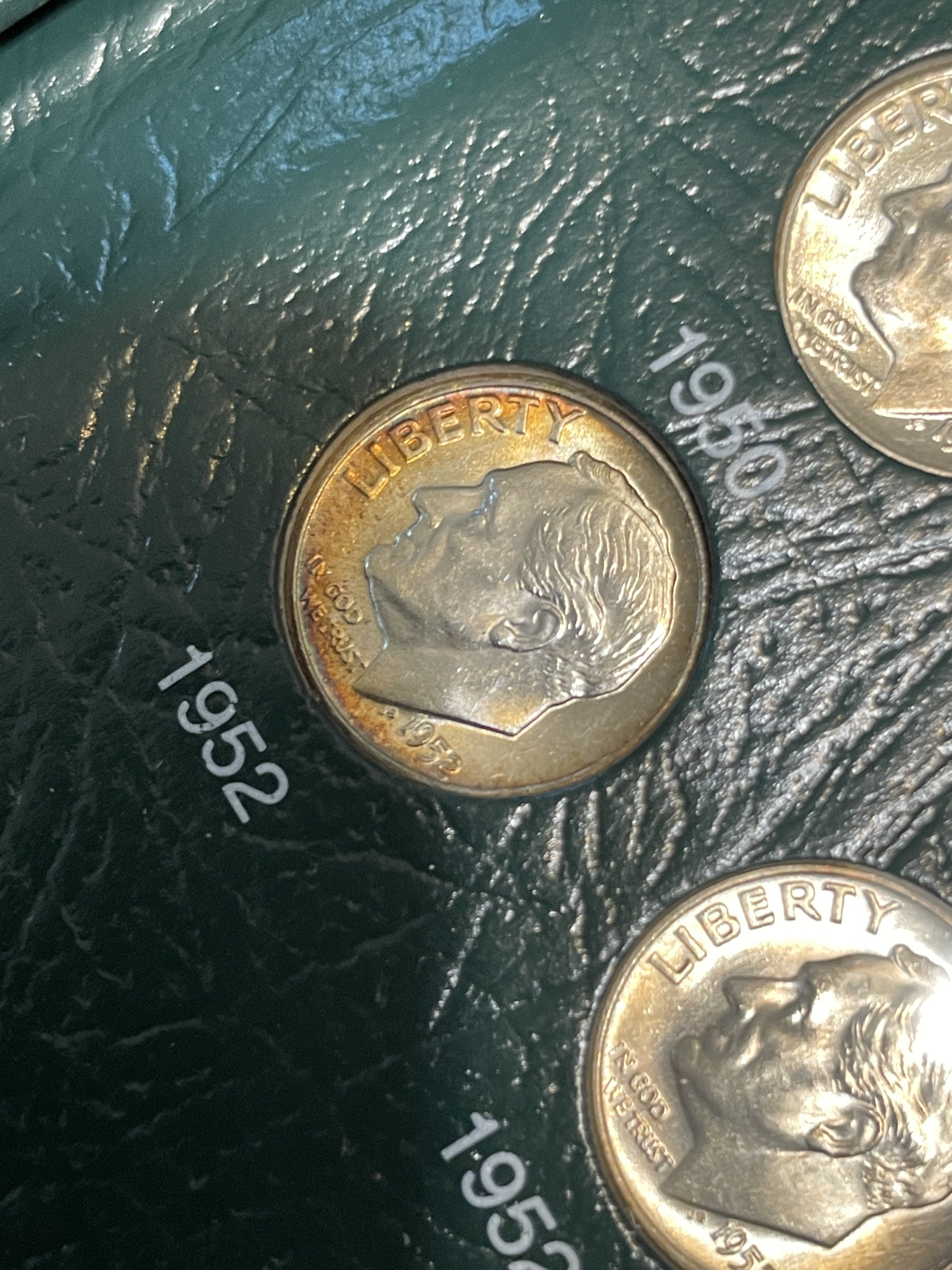
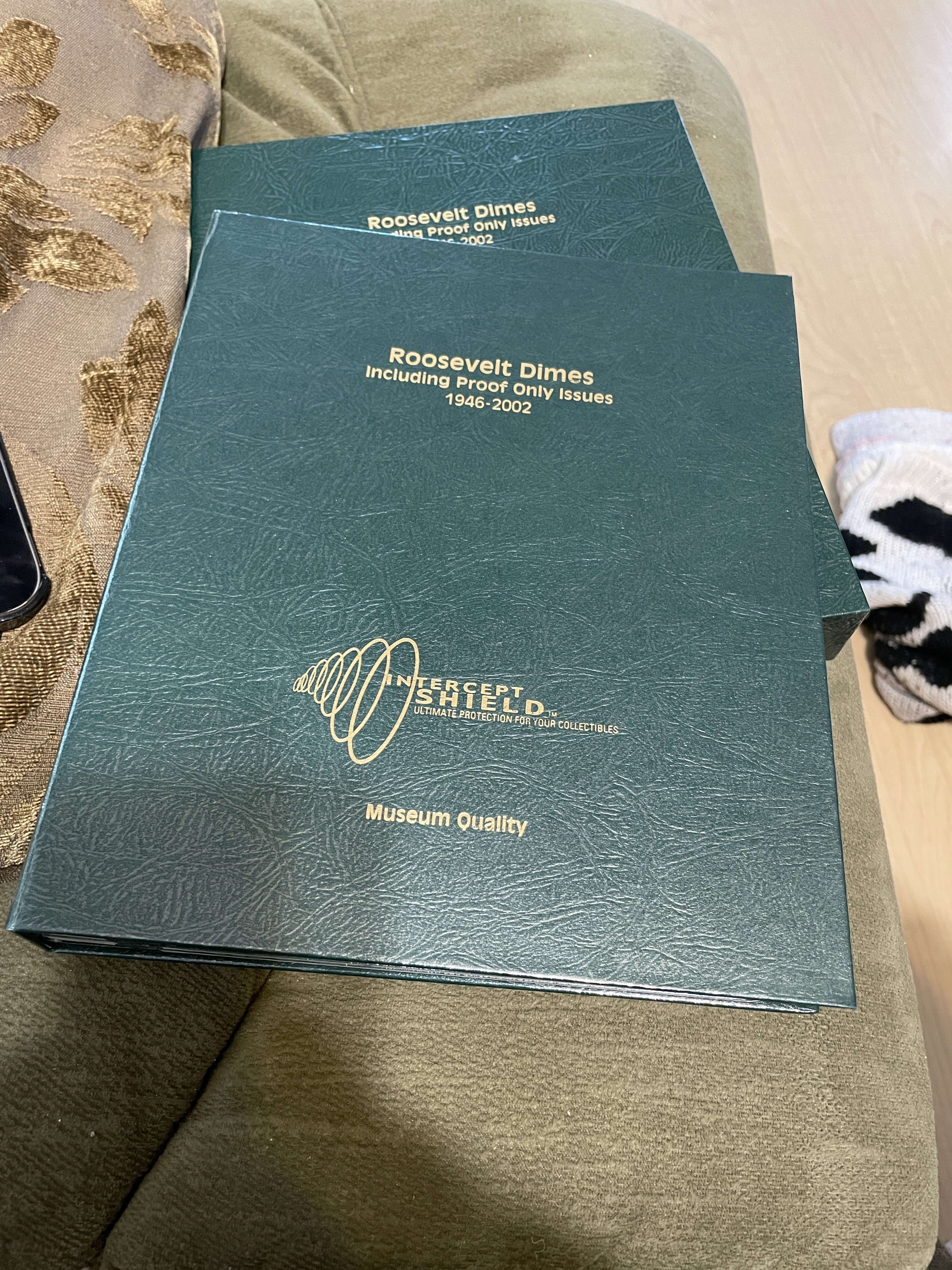
Mr_Spud
I thank Mr. Spud for bringing up album toning and in particular, Intercept Shield albums.
I have a few. Some are completed Lincoln cent albums I've had stored for ten to twenty years.
I've noticed over time the coins that went in- XF/AU light brown remained. The cents that were MS red have some mellowed to a delightful (to me at least) tone.
Here are my examples:
XF/AU Lincolns:
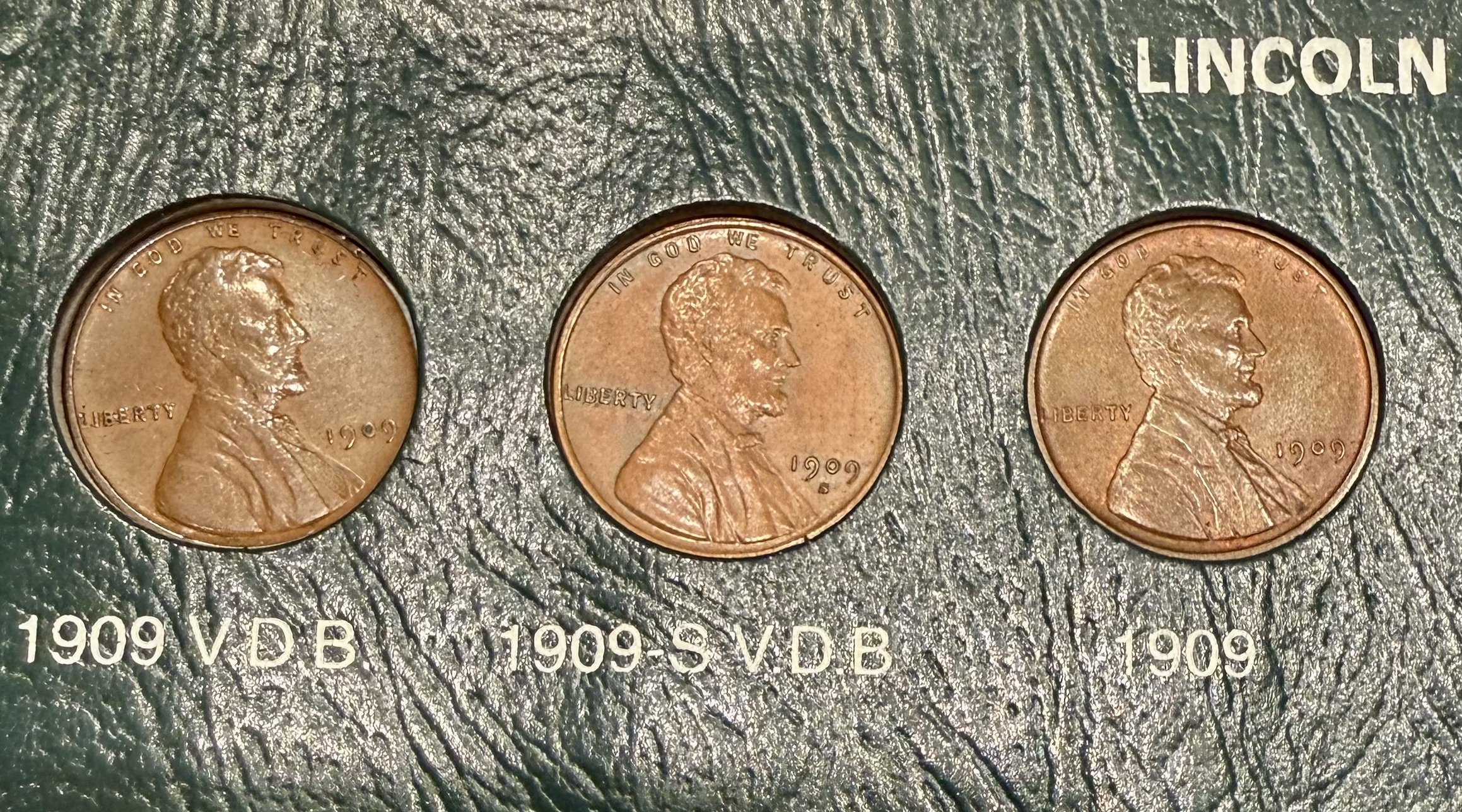
MintState cents:
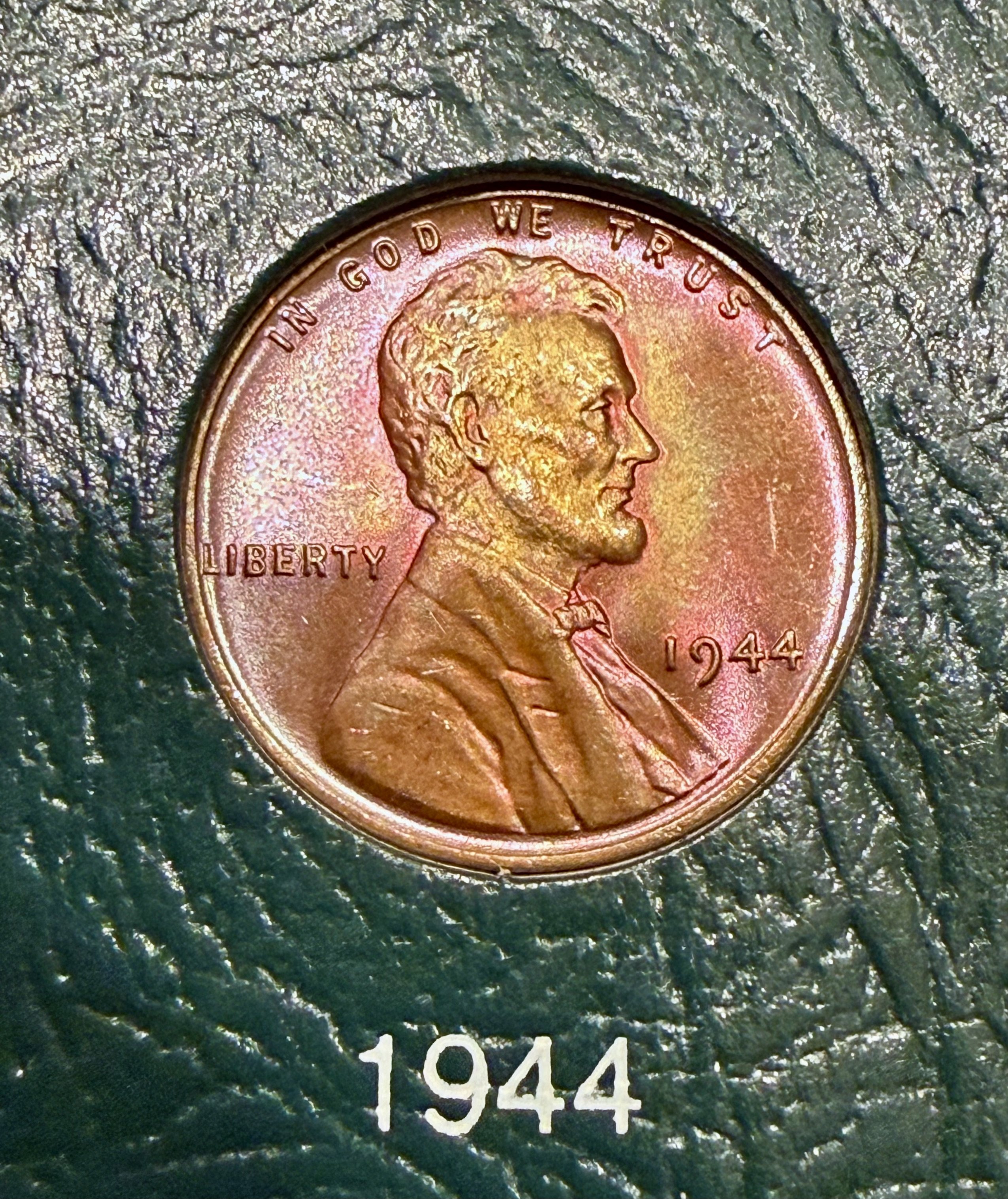
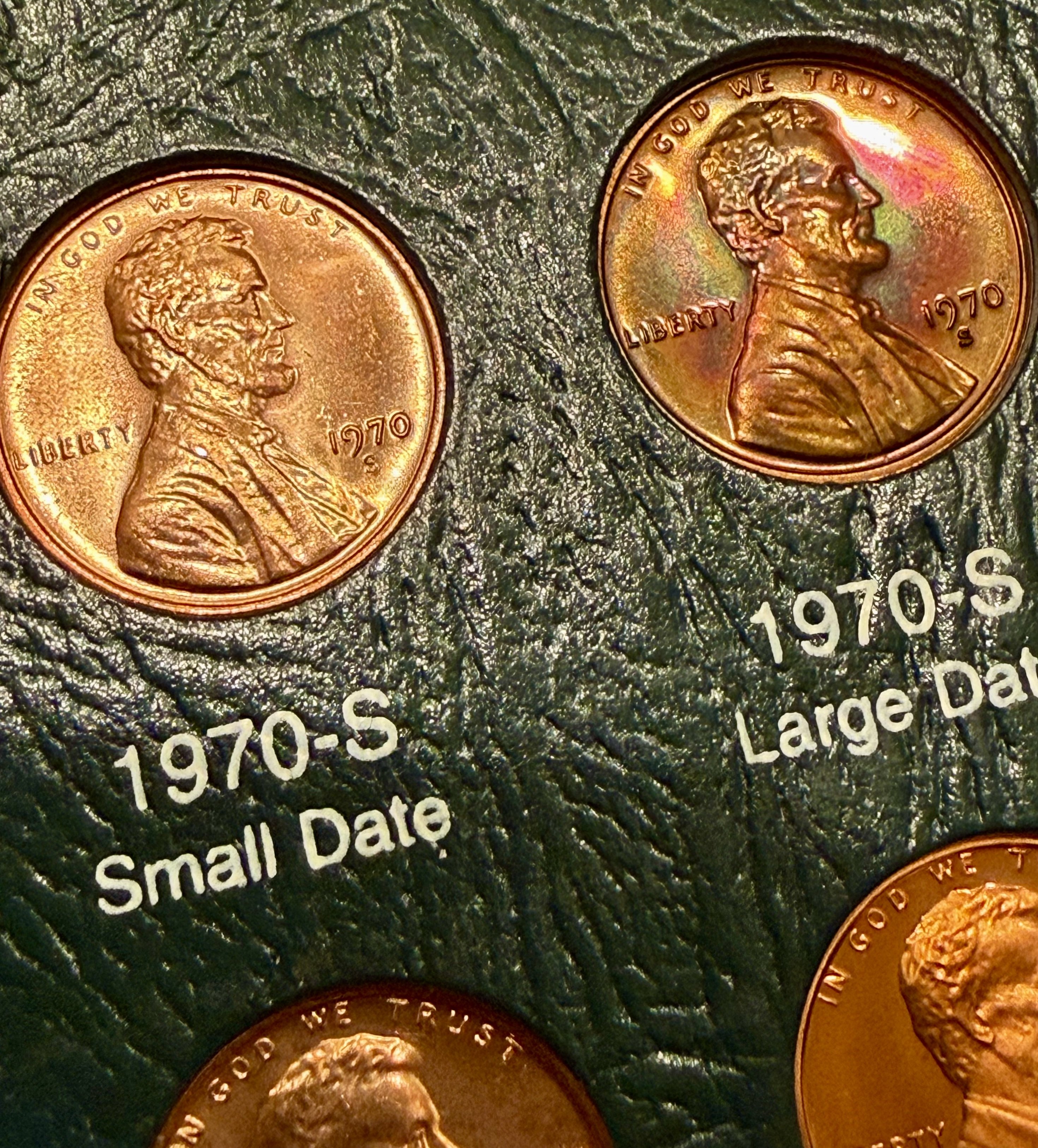
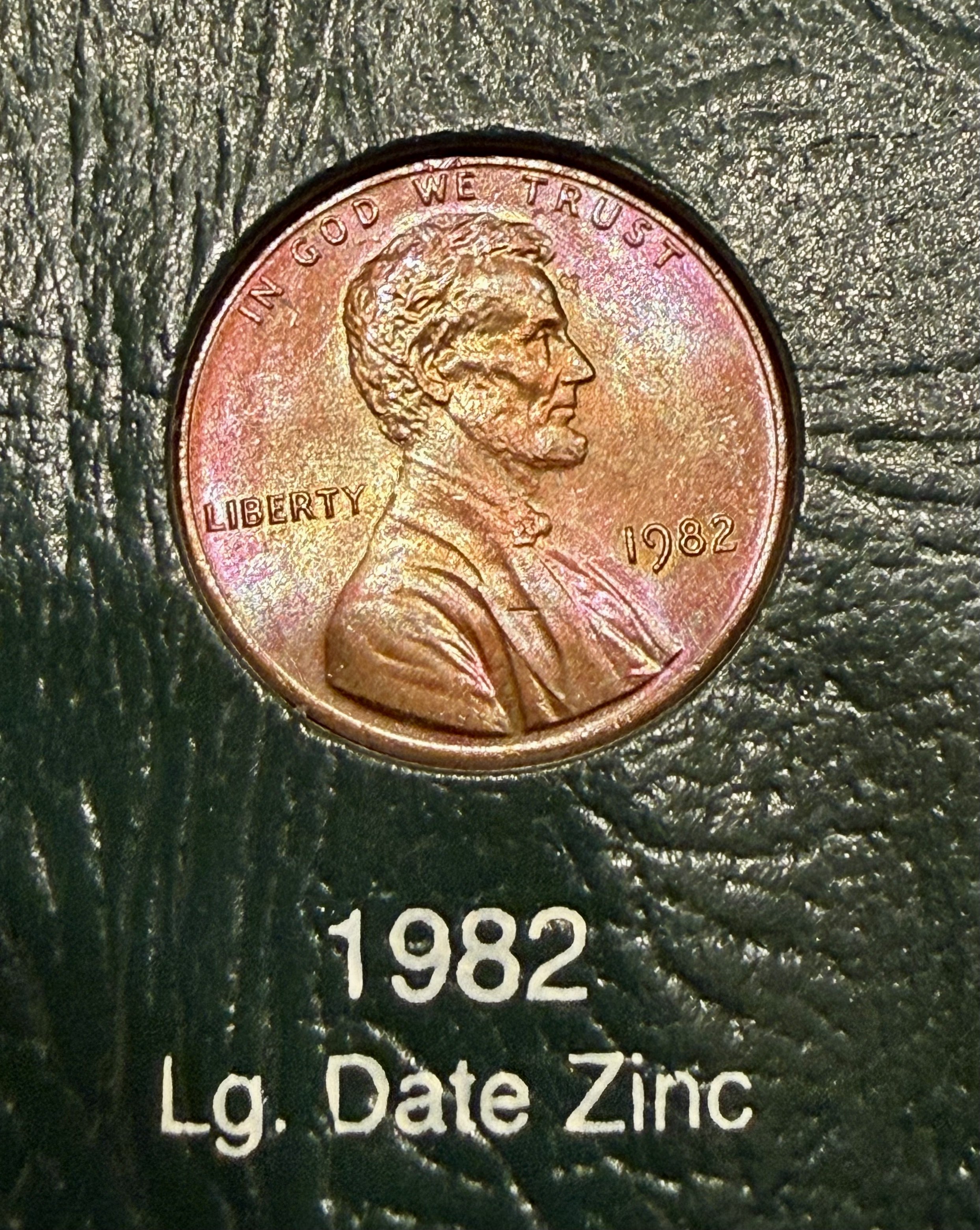
Mud is flying everywhere while he tries to spin out of this mud pit. Will he escape or have to be pulled out of there all covered with mud.
Good points, but I still feel that adding chemicals to the equation, to me, it's not a natural process. Storing coins amongst Taco Bell napkins is unnatural acceleration of toning by adding sulfur to the environment. To some degree it's the same with storing in an album with traces of sulfur in the cardboard, regardless of whether the owner is cognizant of the sulfur "threat." You're arguing that because one cannot tell the difference, then what one does with a coin regarding toning is pretty much irrelevant. Toning is toning.
Windowsills to me are different. No chemical additions to enhance toning rates. Just solar radiation and some resulting heat. Frankly, I don't know if it works as I've never done it to a coin, but I have seen my scraped 55/54 tone down slowly just sitting on my desk in a flip over 6 months.
The only attempt I've made at accelerating toning was to try to tone down a dipped and extensively hairlined but not cleaned XF 55/54 WB-2 by putting it in a baggie with leaf detritus and hanging it in my garage by a window. After several months, the coin showed no change in color at all, and I remain reluctant to get it graded.
Then lets outlaw artificial toning entirely rather than promoting coin corrosion.
LOL!